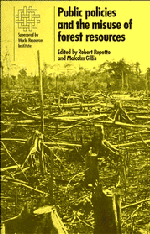Book contents
- Frontmatter
- Contents
- Contributors
- Foreword
- Acknowledgments
- 1 Overview
- 2 Indonesia: public policies, resource management, and the tropical forest
- 3 Malaysia: public policies and the tropical forest
- 4 Incentive policies and forest use in the Philippines
- 5 Price and policy: the keys to revamping China's forestry resources
- 6 Public policy and deforestation in the Brazilian Amazon
- 7 West Africa: resource management policies and the tropical forest
- 8 Subsidized timber sales from national forest lands in the United States
- 9 Conclusion: findings and policy implications
- Index of Topics
6 - Public policy and deforestation in the Brazilian Amazon
Published online by Cambridge University Press: 06 July 2010
- Frontmatter
- Contents
- Contributors
- Foreword
- Acknowledgments
- 1 Overview
- 2 Indonesia: public policies, resource management, and the tropical forest
- 3 Malaysia: public policies and the tropical forest
- 4 Incentive policies and forest use in the Philippines
- 5 Price and policy: the keys to revamping China's forestry resources
- 6 Public policy and deforestation in the Brazilian Amazon
- 7 West Africa: resource management policies and the tropical forest
- 8 Subsidized timber sales from national forest lands in the United States
- 9 Conclusion: findings and policy implications
- Index of Topics
Summary
The Braziliàn Amazon's forest resource
Spanning an area of 5.5 million square kilometers, the Amazon (Figure 6.1) is the world's largest contiguous tropical moist forest. Tropical forests extend into nine South American countries, but in the Amazon the Brazilian portion (3.8 million square kilometers, or 69 percent) is the largest. The Amazon has four main types of vegetation. The dense tropical forest, floresta densa or “hylea” found mainly in the northern Amazon States (Amazonas, Amapá, Roraima, Pará, and Maranhāo), covers 48.8 percent of the region. The less exuberant, shorter, but still continuous “transition forest,” floresta aberta or fina, in the central Amazon (Acre, Rondônia, northern Mato Grosso and Goiás, and western Maranhāo), covers 27 percent of the region. Farther south, mainly in Goiás and southern Mato Grosso, are savannah shrublands, campo cerrado, that cover 17.2 percent of the region. The fourth type, savannah grasslands, campos naturais, occurs mainly in the várzea floodplains, along the Atlantic coast in Amapá and Marajó Islands, and in northern Roraima, and covers only 6.9 percent of the “Legal Amazon” region. The tropical zone embraces about 76 percent of the Brazilian Legal Amazon region (3.8 million square kilometers).
The Brazilian Amazon region alone is believed to contain some 6,000 different tree species (Correa de Lima and Mercado 1985: 152), many endemic to specific areas. The growing stock varies widely in density, from 100 to 270 cubic meters per hectare, but the natural distribution of individual tree species is sparse; an average of 84 to 90 percent of the species are represented by fewer than one individual (more than 15 cm. diameter at breast height – d.b.h.) per hectare (EMBRAPA 1981).
- Type
- Chapter
- Information
- Public Policies and the Misuse of Forest Resources , pp. 247 - 298Publisher: Cambridge University PressPrint publication year: 1988
- 49
- Cited by

